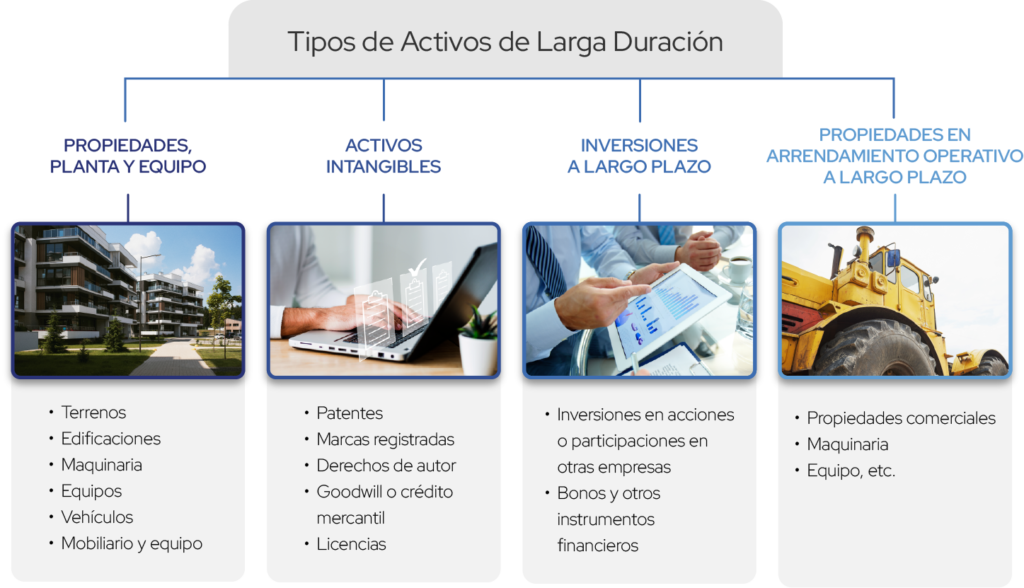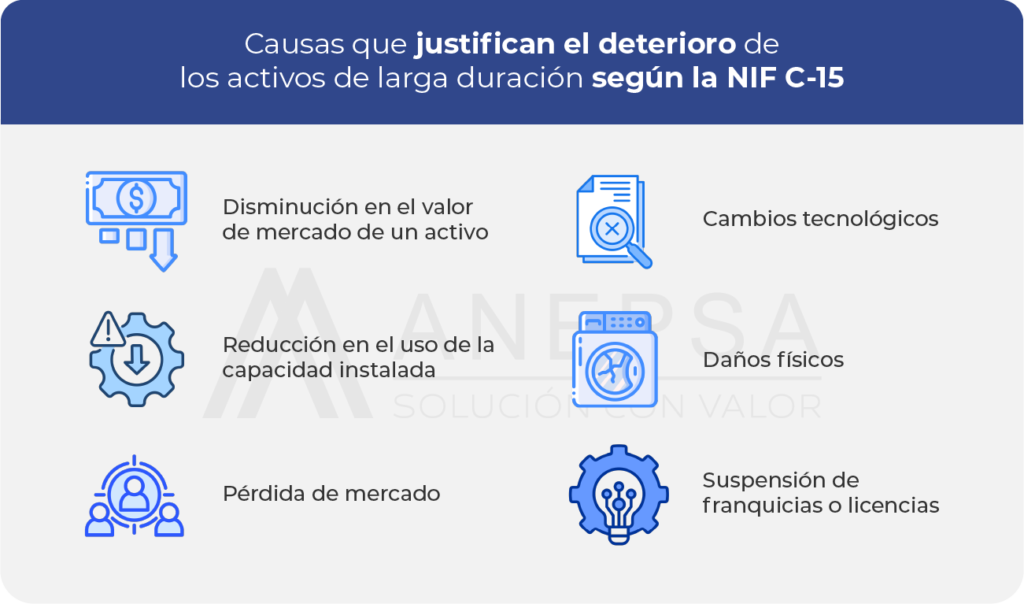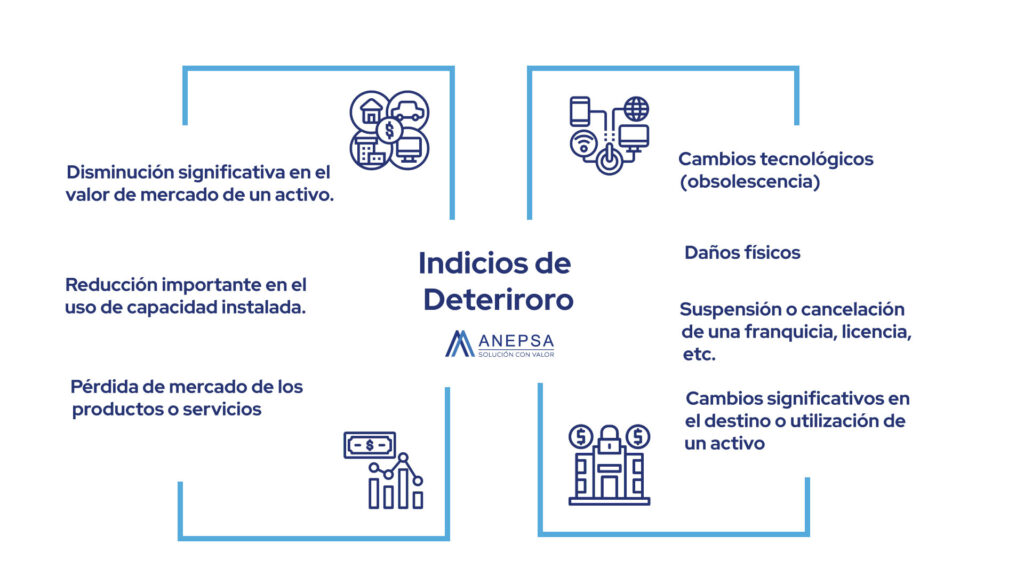
content structure
Financial Reporting Standards Bulletin C-15 sets out key guidelines on the accounting treatment of impairment in long-lived assets, both tangible and intangible. This bulletin is essential for companies to properly recognise and manage impairment losses, while maintaining transparency and reliability in their financial reporting. Below, we explore its content and relevance.
Importance of NIF
Financial Reporting Standards (NIF) play a fundamental role in accounting, as they provide a common framework for the preparation of financial statements in Mexico. Their importance can be summarized in the following key aspects:
- Uniformity and Consistency
The IFRS establish clear principles that companies must follow, ensuring the consistency and comparability of financial information over time and between different entities. - Quality and Transparency
By adhering to IFRS, companies ensure that financial information is of high quality and transparent, which strengthens the confidence of investors and other stakeholders. - Alignment with International Standards
The NIFs are aligned with the International Financial Reporting Standards (IFRS), which facilitates the comparison of financial reports at a global level, favoring the competitiveness of Mexican companies in international markets. - Facilitating Decision Making
Information based on IFRS provides a solid basis for strategic and operational decisions, allowing managers and investors to assess the performance and financial health of companies. - Legal and Tax Compliance
Compliance with NIF is crucial to meet legal and tax requirements in Mexico, as financial statements must adequately reflect the company's activities.
NIF in Mexico
In Mexico, NIFs are issued by the Mexican Financial Reporting Standards Council (CINIF)These rules are essential to regulate the preparation and presentation of financial information in the country, and their correct application is vital to maintain transparency in the business environment. Some key points are:
- Issue and Update
CINIF is responsible for issuing and updating NIFs in collaboration with other institutions such as tax and financial authorities. This ensures that the standards are relevant and applicable in the Mexican economic context. - Compliance with International Standards
IFRS are aligned with International Financial Reporting Standards (IFRS), making it easier to compare financial statements globally. - Mandatory Application
NIFs are mandatory for all entities in Mexico that issue financial statements, both public and private, regardless of their size or sector. - Hierarchy of NIFs
The Mexican regulatory framework is organized into levels: the NIF, the Interpretations of the NIF (INIF), the Auditing Standards (NA), and the Interpretations of the Auditing Standards (INAF), all working coherently to guide the preparation and auditing of financial information.
As a whole, the NIF in Mexico allow for improved quality of financial information, promoting transparency and reliability in companies' accounting reports.
International Financial Standard C-15: Impairment of Long-Lived Assets
The NIF C-15 It is one of the Financial Information Standards (NIF) that regulates the impairment in the value of long-lived assets and their disposition. This standard establishes clear criteria for accounting entities to recognise, measure, present and disclose the impairment of long-lived assets, both tangible and intangible.
Objectives and Scope of NIF C-15
The NIF C-15 aims to ensure that the long-lived assets, both tangible and intangible, are adequately reflected in the financial statements, recognizing the impairment of their value when necessary. These assets, also known as non-current assets, are those that a company acquires with the intention of using them for an extended period, generally more than one year.
Unlike current assets, they are not intended for sale in the normal course of business, but are used to generate income over time. Correct application of IFRS C-15 is essential to ensure that financial statements provide accurate and reliable information to investors and other stakeholders.
Types of Long-Term Assets
- Property, Plant and Equipment (PPE)
- Includes tangible assets that a company uses to produce goods or services. These assets are essential to the company's operations and are not intended for sale. Common examples are:
- land
- buildings
- Machinery
- Equipment
- Vehicles
- furniture and equipment
- Includes tangible assets that a company uses to produce goods or services. These assets are essential to the company's operations and are not intended for sale. Common examples are:
- Intangible Assets
- These are non-physical assets that have economic value for the company. These assets are used for several years and have a significant impact on revenue generation. Some examples are:
- patents: Exclusive rights to make, sell, or use an invention for a specified period.
- Trademarks: Exclusive rights to the use of names, logos or symbols that identify the company.
- Copyright: Legal protection granted to creators of original works.
- Goodwill or commercial credit: Value related to a company's reputation, clientele, or business relationships.
- Licenses: Authorizations to carry out certain activities or businesses, such as operating in specific markets.
- These are non-physical assets that have economic value for the company. These assets are used for several years and have a significant impact on revenue generation. Some examples are:
- Long-term investments
- These are investments that a company intends to hold for a long period, usually more than one year. This may include:
- Investments in shares or shares in other companies.
- Bonds and other financial instruments which is not planned to be sold in the short term.
- These are investments that a company intends to hold for a long period, usually more than one year. This may include:
- Properties under long-term operating lease
- If a company has property that is leased on a long-term basis, these assets are also considered long-lived. They may include commercial property, machinery, or equipment that is not owned but is used for a long period under an operating lease.

Characteristics of Long-Lived Assets
- Long shelf life: These are assets that are expected to produce economic benefits over several years.
- Not intended for sale: Unlike current assets (such as inventory or accounts receivable), long-lived assets are not sold in the ordinary course of business.
- Continued use: They are used in the company's operational activities to generate revenue and improve the efficiency of operations.
Key points of NIF C-15
- Identifying Signs of Impairment: IFRS C-15 provides specific criteria for identifying signs of impairment in the value of assets. These signs include:
- Significant decrease in the market value of an asset.
- Reduction in the use of installed capacity.
- Loss of market or demand for the products or services associated with the asset.
- Technological changes that may lead to obsolescence.
- Physical damage to the asset.
- Suspension or cancellation of a franchise or license associated with the asset.
- Changes in the destination or use of an asset.
- These indications must be evaluated to determine whether it is necessary to proceed with a detailed valuation and determine whether an impairment in the value of the assets should be recognized.
- Calculation and Recognition of Impairment Losses: The standard establishes the Rule for the calculation and recognition of impairment lossesImpairment is recognized when the net book value of an asset exceeds its recovery value, which is the largest of:
- use value: The present value of future cash flows expected to be obtained from the use of the asset.
- net sale price: The estimated selling price of the asset in an arm's length transaction, less the costs associated with its disposal.
- If the net book value of an asset is greater than its recovery value, an impairment loss must be recognized and recorded in the income statement.
- Rules for Presentation and Disclosure of Assets Subject to Impairment: NIF C-15 also establishes the Presentation and disclosure rules applicable to assets subject to impairment. These include:
- The presentation of impairment loss separately in the financial statements, to ensure that users can clearly distinguish between assets that have been impaired and those that have not.
- The revelation of the assumptions and methodologies used to determine the recovery value, such as the discount rate used to calculate the present value of future cash flows.
- In addition, entities are required to disclose any reversal of an impairment loss when the asset's salvage value increases in the future, ensuring that decisions based on the financial statements reflect the asset's current position.
- Presentation and Disclosure of Discontinuation of Operations: In the event that an entity decides to discontinue an operation or dispose of a significant asset, NIF C-15 also establishes specific rules for the Presentation and disclosure of assets subject to discontinuation of operations. The rules include:
- Separate presentation of assets and liabilities related to discontinued operations in the financial statements.
Detailed disclosure of the reasons for discontinuing operations and any financial impact related to the disposition of the assets, such as losses or gains on sale.
Causes justifying the impairment of long-term assets according to NIF C-15
According to this standard, the following causes must be justified to determine the impairment of long-lived assets:
1. Decrease in the market value of an asset
A significant decrease in the market value of an asset can be a clear indication of impairment. This decline can be due to a number of factors, such as an economic crisis, changes in market conditions or variations in demand for the goods or services associated with the asset.
- Example: A commercial building whose market value has decreased due to falling prices in the real estate market, or a vehicle that has suffered a reduction in value due to accelerated depreciation caused by the increased supply of used vehicles on the market.
- Justification: A decline in market value may reflect that the net sales price or value in use of the asset has decreased, suggesting that the asset's carrying amount may be higher than its recoverable amount.
2. Reduction in the use of installed capacity
When there is a significant reduction in the utilisation of the installed capacity of an asset, such as machinery or production equipment, this may indicate impairment. Installed capacity refers to the amount of output a company can generate using its assets. If it is not fully utilised or is under-utilised for a long period, the value of the asset is likely to suffer.
- Example: A manufacturing plant that, due to a decrease in demand for products, operates at a very low capacity for an extended period. It may also be the case of machinery whose use has been reduced due to the modernization of technology in the industry.
- Justification: If the asset is not being used efficiently or if its income-generating capacity is reduced, it may not recover its original value, which implies the need to assess its impairment.
3. Market loss
Market loss refers to a decline in demand for the products or services associated with an asset. This can be a result of factors such as changing consumer preferences, increasing competition, or the exhaustion of a market niche.
- Example: A company that produces products in a market that has become saturated or is losing ground to more innovative or lower-priced competitors. It could also be the case of a company whose product line is discontinued or displaced by more in-demand alternatives.
- Justification: If the market loss affects the profitability or value of the assets related to the production of those goods or services, it may be necessary to recognize an impairment loss, since the asset will probably not generate the expected cash flows.
4. Technological changes
Technological advances can cause an asset to become obsolete, which could reduce its value. This type of impairment occurs when the technology supporting the asset has become obsolete, and the asset is no longer competitive or profitable.
- Example: A computing machine that can no longer operate new software due to its incompatibility with current technologies. Another example could be a software system that is no longer updated, and which loses functionality compared to more modern alternatives.
- JustificationTechnological advancement may cause an asset to lose some of its value because maintenance costs, lack of parts, or inability to adapt to new market demands decrease its ability to generate income. This would justify an impairment assessment.
5. Physical damage
Physical damage to long-lived assets, such as machinery, buildings or vehicles, can affect their value and performance. This damage can result from accidents, natural disasters (such as floods or earthquakes), or wear and tear due to age and overuse of the asset.
- Example: A building that suffers major structural damage due to an earthquake or a machine that breaks down beyond repair due to an accident at the production plant.
- JustificationPhysical damage can significantly reduce the asset's ability to generate income, which may cause the asset's carrying amount to exceed its recoverable amount, making it necessary to recognize an impairment loss.
6. Suspension of franchises or licenses
The suspension, cancellation or expiration of a franchise, license or other rights associated with an intangible asset may reduce its value and lead to impairment. This is particularly relevant in the case of intangible assets such as licenses, copyrights, patents or trademarks, which have economic value based on their validity and ability to generate income.
- Example: A company that loses rights to a patent, or a franchisor whose franchise is cancelled or not renewed due to failure to meet certain standards or legal issues.
- Justification: The loss of these rights or the suspension of the franchise may eliminate the source of income associated with these intangible assets, justifying the evaluation of their impairment and the possible need to recognize a loss.

What are the Signs of Deterioration?
Impairment occurs when the net carrying amount of a long-lived asset (in use or for disposal) exceeds the expected future economic benefits from it. Signs of impairment include:
- Significant decrease in market value of the asset.
- Significant reduction in installed capacity.
- Market loss of related products or services.
- Technological obsolescence.
- Physical damages in the asset.
- Suspension or cancellation of franchises, licenses, etc.
- Significant changes in the use or destination of the asset.

Determination, Calculation and Recognition of Impairment Loss on Assets
Use Value
He use value refers to the present value of the future cash flows expected to be obtained from the use of the asset. To calculate this value:
- Projection of future cash flows generated by the asset.
- Discounting of these flows using an appropriate discount rate.
- Exclusion of financial expenses and depreciation.
- Net Sale Price
He net sales price The value that would be obtained by selling a long-lived asset in an open market transaction, after discounting disposal costs. An observable market is required to determine this price.
- Long-Lived Assets in Use
When a possible impairment of an asset is detected, it is crucial to assess the loss in value, unless it can be demonstrated that the indications of impairment are temporary. Impairment is recognised if:
- He use value either net sales price is less than the net book value of the asset or cash-generating unit.
If the recovered value (value in use or net sales price) is higher than the net book value, there is no impairment.
- Determination of Recovery Value
He recovery value It is the highest value between the use value and the net sales price. If the net book value exceeds the recovery value, a charge should be recognized. impairment loss.
- Impairment Loss Recording
When an impairment loss is determined, it must be recorded as a specific category in the financial statements, distributed proportionally among the long-lived assets affected. However, assets whose impairment loss is not recognized are excluded. net sales price is equal to or greater than its net book value.
- Reversal of Impairment Loss
If conditions improve and the recovery value exceeds the net carrying amount, the impairment loss should be reversed, provided there is evidence that the reversal is permanent and verifiable. Situations that could lead to a reversal include:
- Significant changes in the market or in the economic conditions.
- Decrease in market interest rates.
- Appearance of observable markets for the sale of the asset.
Assets Available for Sale
For an asset to be classified as available for sale, the following criteria must be met:
- Commitment to a sales plan: The asset sale plan has been approved and its execution has been committed to.
- Start of the sales plan: The sales process has begun or at least a market for it has been identified.
- Short-term compliance: The sales plan must be executed within a short period, usually within the next 12 months.
- Price estimate: There is a reasonable estimate of the price that will be obtained from the sale of the asset.
- Stability of the plan: No significant changes to the sale plan or its cancellation are expected.
Considerations on Related Liabilities
In addition to the assets available for sale, the liabilities associated with these assets must be considered, which may be assumed by the buyer in the sales process. The goodwill related to the asset in question.
- impairment loss: If the net book value (NBV) of the asset is greater than the net sales price (NSP), a discount must be recognized. impairment loss, provided the requirements are met, which could generate a provision.
- PNV ReviewIt is important to periodically review the estimate of the net sales price. This could result in an adjustment to the recognized impairment loss.
- Adjustments to impairment losses: Increases in impairment losses will decrease the updated net book value of the asset and should be recognized in the results of the corresponding period.
Return of Assets to Use
If an asset that had been classified as available for sale is returned to its use, it should be valued at the lower of the following values:
- Original net worth, adjusted for depreciation and accumulated impairment to the date of revaluation.
- Recovery value of the asset, determined based on the future cash flows expected to be generated.
This adjustment must be recorded in the results of the period in which the change occurs.
Asset Abandonment
When the decision is made to abandon an asset, certain accounting steps must be followed:
- Calculation of possible impairment loss: An assessment must be made of whether the net book value (NBV) of the asset exceeds its recovery value, in which case an impairment loss must be recognised. This calculation must be made based on expected future cash flows and any other relevant factors.
- Estimation of remaining useful life: The remaining useful life of the asset must be recalculated based on its new purpose and operating conditions. The useful life may be affected by abandonment, which will influence its future depreciation.
- Depreciation of the new VNL: Once the potential impairment loss has been determined and the net book value adjusted, the new NLV should continue to be depreciated until such time as the asset is completely abandoned or is no longer in use. As long as the asset remains in operation, it should remain classified as “in use” in the financial statements, regardless of the abandonment decision.
Asset Exchange
When deciding to exchange long-lived assets, certain accounting procedures must be followed to ensure that the value of the assets is properly reflected. In particular, an accounting procedure must be carried out impairment test to check whether the value of the exchanged assets has not suffered a significant decrease. The key steps are detailed below:
- Impairment test: Before proceeding with the exchange, it is essential to perform an assessment to determine whether the net book value (NBV) of the exchanged assets exceeds their recovery value. The impairment test should be based on the comparison between the net book value (NBV) of the exchanged assets and the net book value (NBV) of the exchanged assets. use value of the assets before and after the exchange. If the recoverable value of the exchanged asset is less than its net carrying amount, an impairment loss must be recognised.
- use value: The value in use of the asset (calculated from expected future cash flows) must be ensured to remain constant before and after the exchange. If the exchange does not substantially affect the value in use of the asset, no adjustment to the estimate of future cash flows is necessary.
- Accounting record of the exchange: If the exchange of assets results in an impairment, the impairment loss should be recognized and reflected in the entity's financial statements, adjusting the net carrying amount of the asset according to the assessment made. If no impairment occurs, the exchanged asset should continue its useful life and be depreciated according to the new conditions of use, if applicable.
Bulletin C-15 establishes clear and practical guidelines for the management of impairment of long-lived assets, ensuring that companies properly recognize and record impairment losses. Its correct application is essential to maintain reliability and transparency in financial statements, facilitating informed decision-making and compliance with accounting and tax regulations in Mexico.



